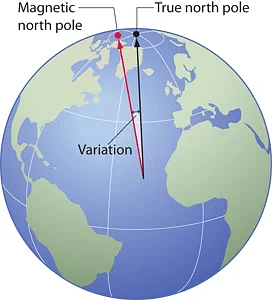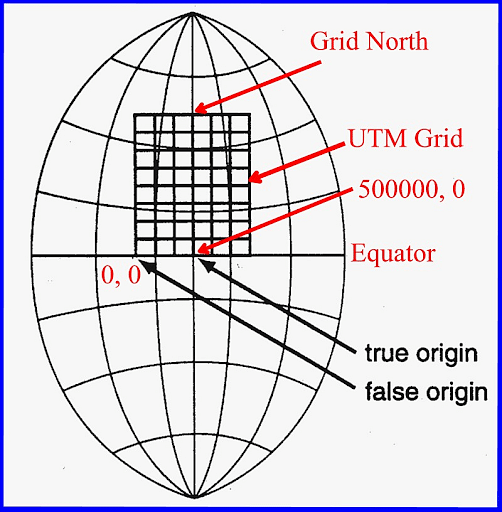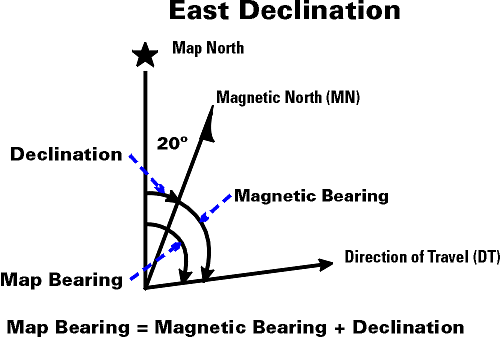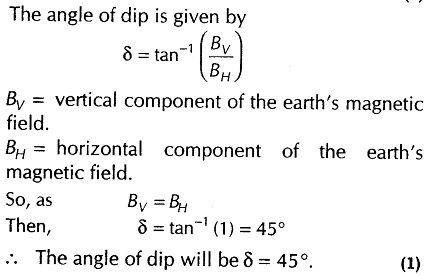
Jasmine Grover Content Strategy Manager
Content Strategy Manager
Magnetic Declination refers to the direction and amount of variation between the Magnetic Pole and True North. Amount and direction of declination depend upon how those two poles align relative to a given point on Earth. Magnetic Declination can be characterized as the angle on the level plane between magnetic and true north.
| Table of Contents |
Key Terms: Compass, Bar Magnet, magnetic field, North Pole, Magnetism and Matter, The Earth's Magnetism, Magnetic Pole, Magnetic Declination
Read More: Magnetic Properties of Materials
What is Magnetic Declination?
[Click Here for Sample Questions]
Magnetic declination is the angle on the level plane between magnetic and true north. This isn't predictable and continues to change depending upon the circumstance upon the world's surface and time. The Greek letter δ is perceived as the magnetic declination image and is generally called magnetic variation.

Magnetic Declination
The declination will be positive when the magnetic north is east of the true north, and the declination will be negative when the magnetic north is west of the true north. Isogonic lines (when the lines along the declination are reliable) and agonic lines (when the lines along the declination are zero) are some of the terms used to describe magnetic declination.
| Frequently Asked Questions Question: What is called magnetic dip? Answer: Magnetic dip, dip angle, or magnetic inclination is the angle made with the horizontal by the Earth's magnetic field lines. This angle varies at different points on the Earth's surface. Question: What is magnetic declination and dip? Answer: The angle between the magnetic meridian and geographic meridian at a place is called Magnetic Declination at that place. Magnetic Inclination or Angle of Dip is the angle between the direction of the total magnetic field of Earth and a horizontal line in the magnetic meridian. |
Also check:
| Related Concepts | ||
|---|---|---|
| Magnetic Spectrum | Faraday's Law | Magnetometer |
| Magnetisation and Magnetic Intensity | NCERT Solutions Chapter 5 Magnetism and Matter | Magnetic Declination |
Types of North
[Click Here for Previous Year Questions]
Magnetic declination is the direction and amount of variation between the Magnetic Pole and True North.
There are three types of the north such as:
- True North
- Grid North
- Magnetic North
True North
True north is the direction along the world's surface towards the real North Pole or the topographical North Pole. It is otherwise called geodetic north and is not the same as the magnetic north which is the direction pointed by the compass and from the grid north which is toward the path along the network lines towards the north.
Read More: Moving Charges and Magnetism

North Pole
Grid North
Grid north is the direction pointed to the northwards along the framework lines on a guide projection. This term is utilized for route and the deviation of the grid north from the true north is extremely less.
Read More: Biot-Savart Law

Grid North
Magnetic North
Magnetic north is the direction which is pointed by the compass needle because of the world's magnetic field. The deviation between the true north and the magnetic north shifts from one spot to another as the world's magnetic poles are not fixed concerning its pivot.

Earth’s Magnetic Field
| Frequently Asked Questions Question: Briefly describe the three types of north and their meaning. Answer: Map users need to understand that there are three different types of north. The three north are the True, the Grid, and Magnetic north. The term Grid north is used in map projection to refer to the direction northwards along the grid lines in the navigation sector. Question: Why is there a difference between grid north and true north? Answer: The difference between true north and grid north is an inherent effect of transforming the earth's spherical surface to a plane surface. The size of this difference for a particular map depends on the projection and the map location relative to the projection origin. |
Read More: Earth’s Magnetic field
What is Magnetic Dip?
[Click Here for Sample Questions]
The magnetic dip can be characterized as the edge by the world's magnetic field lines made with the horizontal. It is generally called dip angle or magnetic inclination and was found by Georg Hartmann in the year 1544.
Right when the inclination is said to be positive, it shows that the world's magnetic lines are pointing lower or downwards in the northern portion of the globe and when the inclination is said to be negative, the world's magnetic lines are facing vertically or upwards in the southern side of the equator.

Magnetic Field Lines
In the year 1581, Robert Norman discovered a dip circle which is a method to gauge the dip angle or magnetic inclination. Various terms used are isoclinic lines (when the shape lines are comparable at the world's surface) and aclinic lines (when the locus of the focuses are having zero dips).
Also check:
| Related Concepts | ||
|---|---|---|
| Magnetic Declination | Magnetic Properties | Magnetic Force and magnetic field |
| Derivation of Biot Savart Law | Electric Flux | Inductance Formula |
Formula to Calculate Magnetic Declination
[Click Here for Previous Year Questions]
One can calculate Magnetic Declination in the following ways:
- From the declination calculator
- From the declination chart
- From the compass
From the declination calculator: The declination calculator is a basic technique to calculate the declination of any area on the earth. By giving the year, degree, and longitude of a given region, the calculator gives the declination dependent on magnetic reference field models.
From a magnetic declination chart: A magnetic declination chart is an aid to calculate the magnetic declination. The chart readily provides information on the world’s magnetic fields. This is the easiest solution to finding magnetic declination.

Magnetic Declination Chart
Read More: Magnetism and Gauss’s Law
From a compass: There are three types of bearing such as true, magnetic, and compass bearing. These three are associated by the expression:
| T = M + V M = C + D T = C + V + D |
(which is an overall condition relating to compass and genuine bearing)
Where,
- C → Compass bearing
- M → Magnetic bearing
- T → True bearing
- V → Variation
- D → Compass deviation
- V < 0, D < 0 → This addresses westerly variation and deviation
- V > 0, D > 0 → This addresses easterly variation and deviation
Following are the formula to calculate magnetic and compass bearing.
- True bearing – Variation = Magnetic bearing
- Magnetic bearing – Deviation = Compass bearing

East Declination Diagram
Following are the formula to calculate magnetic and true bearing.
- Compass bearing + deviation = Magnetic bearing
- Magnetic bearing + variation = True bearing
Thus it is clear that when we check for the north direction using a compass, the needle is truly pointing towards the world's magnetic north and not the genuine/true north.
Check out:
Things to Remember
- Magnetic declination can be characterized as the angle on the level plane between magnetic and true north.
- The declination will be positive when the magnetic north is east of the true north, and the declination will be negative when the magnetic north is west of the true north.
- There are three types of north such as True North, Grid North and Magnetic North.
- True north is the direction along the world's surface towards the real North Pole or the topographical North Pole.
- Grid north is the direction pointed to the northwards along the framework lines on a guide projection.
- Magnetic north is the direction which is pointed by the compass needle because of the world's magnetic field.
- Magnetic declination can be calculated by using a declination chart, calculator or by using the compass.
Read More: Magnetic Field on the Axis of a Circular Current Loop
Sample Questions
Ques. What is the Importance of Magnetic Declination? (2 marks)
Ans. Magnetic declination is a significant idea for the exact route. A compass will consistently point along the lines of magnetic power (which join on what are known as the magnetic poles). The angle between the power direction and the bearing of the geographic north pole is known as the declination. If a compass at your area is highlighting to the right of true north, declination is positive or east, and if it focuses on another side of true north, declination is negative or west. This is measured in terms of degrees and minutes east or west to show the direction of magnetic north from true north.
Ques. How to Calculate the Declination at any Given Place? (2 marks)
Ans.
- One way is to use declination maps. Tragically in light of secular variation, values of declination are continually evolving. When printed maps were the main method of getting this data, the values of declination were fairly outdated when the maps got to the overall population. As indicated by Nathaniel Bowditch, American practical navigator the magnetic declination can be said as the angle between the magnetic and geological meridians at any place.
- Another way is to perform a prediction. This ought to be founded on an overall exact model of the profound streams. The model reflects a highly predictable pace of progress, and will, as a rule, be more precise than a guide, and never less exact.
Ques. What is the angle of dip at a place where the horizontal and vertical components of the earth’s magnetic field are equal? (CBSE 2012) (2 marks)
Ans.

Ques. A magnetic needle is free to rotate on a vertical plane and orients itself vertically at a certain place on the earth. What are the values of
(i) The horizontal component off the earth’s magnetic field and
(ii) angle of dip at this place? (CBSE 2012) (2 marks)
Ans. (i) The coil is free to move in the vertical plane, which means that there is no component at the earth’s magnetic field in the horizontal direction, so the horizontal component of the earth’s magnetic field is 0.
(ii) The angle of dip is 90°.
Ques. Define the term magnetic declination. (CBSE 2009) (2 marks)
Ans. Magnetic declination The angle between geographical meridian and magnetic meridian at any place of the earth is known as magnetic declination at that place of the earth.
Ques. Write two properties of a material suitable for making a permanent magnet. (CBSE 2017) (2 marks)
Ans. Properties of material for making a permanent magnet:
- High retentivity
- High coercivity
- High permeability
Ques. A magnetic needle free to rotate in a vertical plane parallel to the magnetic meridian has its North tip down at 60° with the horizontal. The horizontal component of the earth’s magnetic field at the place is known to be 0.4 G. Determine the magnitude of the earth’s magnetic field at the place. (CBSE 2011) (2 marks)
Ans.

Ques. Draw magnetic field lines when a
(i) diamagnetic
(ii) paramagnetic substance is placed in an external magnetic field.
Which magnetic property distinguishes this behaviour of the field lines due to the two substances? (2 marks)
Ans.
(i) When diamagnetic material is placed in an external magnetic field.

(ii) When a paramagnetic material is placed in an external magnetic field.

Magnetic susceptibility distinguishes this behaviour of the field lines due to the two substances.
Ques. A magnetic needle free to rotate in a vertical plane parallel to the magnetic meridian has its northern tip down at 60° with the horizontal. The horizontal component of the earth’s magnetic field at the place is known to be 0.4 G. Determine the magnitude of the earth’s magnetic field at the place. (CBSE 2011) (2 marks)
Ans.

Ques. (a) How is an electromagnet different from a permanent magnet?
(b) Write two properties of a material that make it suitable for making electromagnets. (CBSE 2013) (2 marks)
Ans. (a) A permanent magnet is prepared from a ferromagnetic material, which retains magnetic properties for a long time at room temperature while
- An electromagnet consists of a core made of a ferromagnetic material placed inside a solenoid. It behaves like a permanent magnet as long as a current flows through it.
(b) Properties of material :
- high permeability
- low retentivity
- low coercivity
Previous Year Questions
- A compass needle which is allowed to move in a horizontal plane… [NEET 2012]
- A diamagnetic material in a magnetic field moves… [NEET 2003]
- A magnetic needle suspended parallel to a magnetic field requires… [NEET 2012]
- A vibration magnetometer placed in magnetic meridian has a small bar magnet… [NEET 2010]
- According to Curie's law, the magnetic susceptibility of a substance… [NEET 2003]
- An iron rod of susceptibility 599 is subjected to a magnetising field of… [NEET 2020]
- At a point A on the earth's surface the angle of dip… [NEET 2019]
- Electromagnets are made of soft iron because soft iron has… [NEET 2010]
- Following figures show the arrangement of bar magnets in different… [NEET 2014]
- If θ1 and θ2 be the apparent angles of dip observed in two vertical planes… [NEET 2017]
- Curie-Weiss law is obeyed by iron at a temperature… [KCET 2004]
- Earth's magnetic field always has a horizontal component except… [KCET 2021]
- A solenoid has core of a material with relative permeability… [KEAM]
- If a current of 500 mA produces a deflection of… [KEAM]
- A paramagnetic substance of susceptibility… [KEAM]
- If the susceptibility of dia, para and ferro magnetic materials are… [KEAM]
- Materials suitable for permanent magnet, must have which of…
- At what temperature, the ferromagnetic substances become…
- A charged particle (charge q) is moving in a circle of…
- At Curie point, a ferromagnetic material becomes…
For Latest Updates on Upcoming Board Exams, Click Here:https://t.me/class_10_12_board_updates
Check out:







Comments